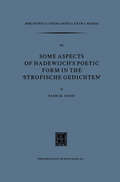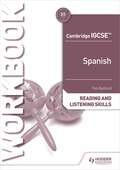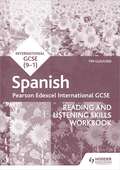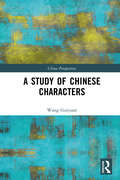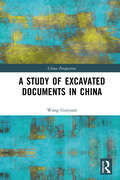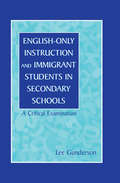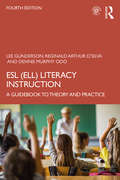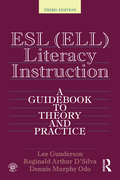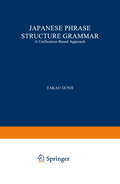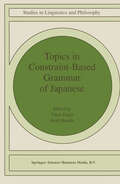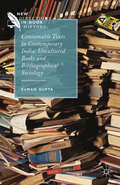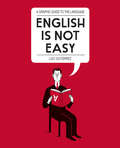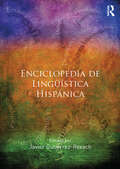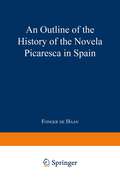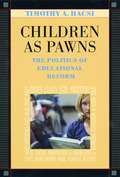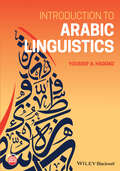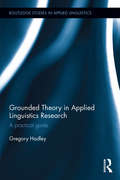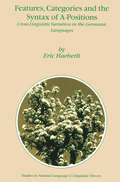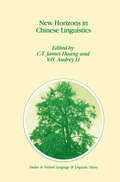- Table View
- List View
Some Aspects of Hadewijch’s Poetic form in the ‘Strofische Gedichten’ (Bibliotheca Neerlandica extra muros #3)
by Tanis M. GuestCambridge IGCSE™ Spanish Reading and Listening Skills Workbook
by Timothy GuilfordThis text has not been through the Cambridge International endorsement process.Develop language mastery with targeted skills activities that support and go beyond the textbook. Written for the Cambridge IGCSET Spanish syllabus, this workbook will enable you to: Explore engaging reading and listening extracts, covering every topic in the syllabus - with 28 audio passages online, plus 28 reading passages. Develop your understanding through activities designed to improve specific reading and listening skills. Build your confidence ahead of assessment with activities that help you understand how to approach different question types. Improve your language skills at your own pace, with extracts split into two sections depending on their difficulty level. Keep track of your progress as you work through clear skills development objectives and check your work against the answers supplied online.
Pearson Edexcel International GCSE Spanish Reading and Listening Skills Workbook
by Timothy GuilfordHelp students develop language mastery with targeted skills development activities that support and go beyond the textbook. Written by a subject specialist, this workbook enables students to:- Discover engaging reading and listening stimulus, covering every topic in the specification - 28 audio passages online, plus 28 reading passages- Develop mastery of texts with specific skills development activities to strengthen their language skills and prepare them for assessment- Build their confidence ahead of assessment with activities that help them understand how to approach different question types- Progress their language skills and maximise their potential whatever their ability level, with two levels of differentiated activities- Make the most of independent learning opportunities with short tasks that could be used as homework, allowing the classroom focus to be on the higher-order skills- Take ownership of their learning with clear skills development objectives and answers online
A Study of Chinese Characters (China Perspectives)
by Wang GuiyuanAs the first volume of a two-volume set on Chinese ancient characters and newly unearthed literature, this book brings together the author’s research articles that discuss the development of Chinese characters and the tradition of Chinese palaeography. The 23 chapters in this book focus on two aspects of Chinese characters. The first 13 chapters centre on the evolution of Chinese characters, analysing the composition system and its transformation, the motivation, and mechanisms behind its evolution, as well as the methodology of the study of ancient characters. The subsequent 10 chapters mainly revolve around Shuowen Jiezi, one of the oldest character dictionaries in China. The author offers a novel understanding of the core issues related to this most important philological work, such as the version of the dictionary, misunderstandings in previous scholarship, and its relations with other palaeographical materials. The title will appeal to students and scholars of Sinology, Chinese philology, and palaeography, as well as Chinese characters.
A Study of Excavated Documents in China (China Perspectives)
by Wang GuiyuanAs the second volume of a two-volume set on Chinese ancient characters and unearthed literature, this book brings together the author’s scholarly works on Chinese scripts studies and unearthed materials. In this volume, the author scrutinizes manuscripts unearthed from archaeological findings, including silk books and bamboo slips discovered in ancient tombs that date back to the Warring States period and the Qin and Han dynasties, as well as Turfan manuscripts. These materials serve as supplements of Shuowen Jiezi and other historical documents, which complement our understanding of ancient characters. Through textual analysis of these newly excavated documents, the author reinterprets the texts and resolves some knotty problems in Chinese palaeography. The title will appeal to students and scholars of Sinology, Chinese philology, and palaeography, as well as Chinese characters and unearthed manuscripts.
English-Only Instruction and Immigrant Students in Secondary Schools: A Critical Examination
by Lee GundersonThis book is for teachers, teacher educators, school and district administrators, policy makers, and researchers who want to know about literacy, cultural diversity, and students who speak little or no English. It offers a rich picture of the incredible diversity of students who enter secondary school as immigrants—their abilities, their needs, and their aspirations. The studies reported are part of a large longitudinal study of about 25,000 immigrant students in a district in which the policy is English-only instruction. These studies:*provide multiple views of the students’ lives and their success in schools where the language of instruction differs from the languages they speak with their friends and families;*explore the students’ views of teaching and learning; *describe the potential differences between the students views and those of their teachers; *look at issues related to students’ views of their identities as they work, study, and socialize in a new environment; and*examine different reading models designed to facilitate the learning of English as a second language (ESL). Educators and researchers will find the descriptions of students’ simultaneous learning of English and of academic content relevant to their view of whether instruction should be English only or bilingual. For teachers who view multicultural education as an important endeavor, this book may on occasion surprise them and at other times confirm their views. The author does not attempt to develop a particular political viewpoint about which approach works best with immigrant students. Rather, the objective of the studies was to develop a full, rich description of the lives of immigrant high school students enrolled in classes where the medium of instruction is English. The reader is left to evaluate the results.
English-Only Instruction and Immigrant Students in Secondary Schools: A Critical Examination
by Lee GundersonThis book is for teachers, teacher educators, school and district administrators, policy makers, and researchers who want to know about literacy, cultural diversity, and students who speak little or no English. It offers a rich picture of the incredible diversity of students who enter secondary school as immigrants—their abilities, their needs, and their aspirations. The studies reported are part of a large longitudinal study of about 25,000 immigrant students in a district in which the policy is English-only instruction. These studies:*provide multiple views of the students’ lives and their success in schools where the language of instruction differs from the languages they speak with their friends and families;*explore the students’ views of teaching and learning; *describe the potential differences between the students views and those of their teachers; *look at issues related to students’ views of their identities as they work, study, and socialize in a new environment; and*examine different reading models designed to facilitate the learning of English as a second language (ESL). Educators and researchers will find the descriptions of students’ simultaneous learning of English and of academic content relevant to their view of whether instruction should be English only or bilingual. For teachers who view multicultural education as an important endeavor, this book may on occasion surprise them and at other times confirm their views. The author does not attempt to develop a particular political viewpoint about which approach works best with immigrant students. Rather, the objective of the studies was to develop a full, rich description of the lives of immigrant high school students enrolled in classes where the medium of instruction is English. The reader is left to evaluate the results.
ESL (ELL) Literacy Instruction: A Guidebook to Theory and Practice
by Lee Gunderson Reginald Arthur D'Silva Dennis Murphy OdoNow in its fourth edition, ESL (ELL) Literacy Instruction combines a comprehensive scope with practical, research-based tools and applications for reading instruction. Designed for use by pre-service and in-service teachers, this guidebook provides the context and expertise to plan and implement reading programs that match the needs and abilities of students at all ages and levels of proficiency. The book explains different models of literacy instruction from systematic phonics to whole language instruction, discusses controversies in the field, and includes specific teaching methods within each model. The fourth edition highlights recent developments in education policy, new models of instruction, and devotes greater attention to issues surrounding assessment. An expanded companion website integrates with the text to offer additional tools and examples, and readers are encouraged to develop their own teaching strategies within their own instructional models. Providing a thorough overview of the history and major issues of ESL (ELL) literacy instruction, this book will be of great interest to pre-service and in-service teachers at all levels, from kindergarten to adult learners.
ESL (ELL) Literacy Instruction: A Guidebook to Theory and Practice
by Lee Gunderson Reginald Arthur D'Silva Dennis Murphy OdoNow in its fourth edition, ESL (ELL) Literacy Instruction combines a comprehensive scope with practical, research-based tools and applications for reading instruction. Designed for use by pre-service and in-service teachers, this guidebook provides the context and expertise to plan and implement reading programs that match the needs and abilities of students at all ages and levels of proficiency. The book explains different models of literacy instruction from systematic phonics to whole language instruction, discusses controversies in the field, and includes specific teaching methods within each model. The fourth edition highlights recent developments in education policy, new models of instruction, and devotes greater attention to issues surrounding assessment. An expanded companion website integrates with the text to offer additional tools and examples, and readers are encouraged to develop their own teaching strategies within their own instructional models. Providing a thorough overview of the history and major issues of ESL (ELL) literacy instruction, this book will be of great interest to pre-service and in-service teachers at all levels, from kindergarten to adult learners.
ESL (ELL) Literacy Instruction: A Guidebook to Theory and Practice
by Lee Gunderson Dennis Murphy Odo Reginald D'SilvaESL (ELL) Literacy Instruction provides both ESL and mainstream teachers with the background and expertise necessary to plan and implement reading programs that match the particular needs and abilities of their students. Comprehensive and research-based, it applies current ESL and reading research and theory to practice. Designed for use by pre-service and in-service teachers at all levels from kindergarten to adult learners, it explains different models of literacy instruction from systematic phonics to whole language instruction and includes specific teaching methods within each model. Multicultural issues are addressed. Instructional matrices that account for the wide variations in ESL (ELL) student backgrounds and abilities form the pedagogical basis of the approach described in the text. The matrices, based on extensive research, involve two easily measured variables that predict what programs and approaches will be comprehensible for learners who vary in age, literacy background, English ability, and program needs. Readers are encouraged to develop their own teaching strategies within their own instructional models.
ESL (ELL) Literacy Instruction: A Guidebook to Theory and Practice
by Lee Gunderson Dennis Murphy Odo Reginald D'SilvaESL (ELL) Literacy Instruction provides both ESL and mainstream teachers with the background and expertise necessary to plan and implement reading programs that match the particular needs and abilities of their students. Comprehensive and research-based, it applies current ESL and reading research and theory to practice. Designed for use by pre-service and in-service teachers at all levels from kindergarten to adult learners, it explains different models of literacy instruction from systematic phonics to whole language instruction and includes specific teaching methods within each model. Multicultural issues are addressed. Instructional matrices that account for the wide variations in ESL (ELL) student backgrounds and abilities form the pedagogical basis of the approach described in the text. The matrices, based on extensive research, involve two easily measured variables that predict what programs and approaches will be comprehensible for learners who vary in age, literacy background, English ability, and program needs. Readers are encouraged to develop their own teaching strategies within their own instructional models.
Japanese Phrase Structure Grammar: A Unification-based Approach (Studies in Natural Language and Linguistic Theory #8)
by T. GunjiThis book is a considerable revision and extension of my thesis for The Ohio State University completed in 1981: A Phrase Structural Analysis of the Japanese Language (Gunji 1981a). The book discusses some of the major grammatical constructions of Japanese in a version of phrase structure grammar called Japanese Phrase Structure Grammar (JPSG), which is loosely based on such frameworks for phrase structure grammar as Generalized Phrase Structure Grammar (GPSG) and Head-driven Phrase Structure Grammar (HPSG). Particular emphasis is placed on the binding and control of pronouns (both implicit - "zero" - and explicit ones, including reflexives) in complementation structures (chapter 4) and adjunction structures (chapter 5). Even though this book started as a revision of my 1981 thesis, the resultant book has few traces of my thinking then. The 1981 thesis was closely related to an early version of GPSG, which was then at a very preliminary stage, and I had only a few preprints of papers by Gerald Gazdar and others to read. GPSG itself has evolved during the past. several years, culminating in a book published last year (Gazdar, Klein, Pullum, and Sag 1985), which differs from the early theory in many ways.
Topics in Constraint-Based Grammar of Japanese (Studies in Linguistics and Philosophy #68)
by Takao GunjiThis collection of papers reports our attempt to sketch how Japanese grammar can be represented in a constraint-based formalism. Our first attempt of this nature appeared a decade ago as Japanese Phrase Structure Grammar (Gunji 1987) and in several papers following the publication of the book. This book has evolved from a technical memo that was a progress report on the Japanese phrase structure grammar (JPSG) project, which was conducted as an activity of the JPSG Working Group at ICOT (Institute for New-Generation Computing Technology) from 1984 to 1992. JPSG implements ideas from recent developments in phrase structure grammar formalism, such as head-driven phrase structure grammar (HPSG), (see Pollard & Sag 1987, 1994) as applied to the Japanese language. The main goal of this project was to state various grammatical regularities exhibited in natural language in general (and in Japanese in particular) as a set of local constraints. The book is organized in two parts. Part I gives an overview of developments in our framework after the publication of Gunji (1987), introducing our fundamental assumptions as well as discussing various aspects of Japanese in the constraint based formalism and summarizing discussions of the JPSG Working Group during the above-mentioned period. Naturally, in the period after the publication of the above book, our discussion was centered on topics not covered in the book.
Consumable Texts in Contemporary India: Uncultured Books and Bibliographical Sociology (New Directions in Book History)
by S. GuptaThrough what he terms "bibliographical sociology", Suman Gupta explores the presence of English-language publications in the contemporary Indian context – their productions, circulations and readerships – to understand current social trends.
English is Not Easy: A Guide to the Language
by Luci GutierrezA quirkily illustrated, brilliantly risqué, but thoroughly practical, guide to the peculiarities of one of the trickiest languages on earth, for (strictly adult) students of English as a foreign language and native speakers alikeDo you know when to use whether opposed to if? For exampIe, I wonder whether I should have added a little more poison to his tea? Or where to place the comma in a conditional sentence? English is Not Easy presents the intricacies of the English language in a whimsically illustrated guide that is appealing even to the grammar averse.If all other language and grammar guides leave you snoring, look no further. English Is Not Easy doesn’t offer run-of-the-mill phrases about extreme sports and atmospheric conditions that you’ll learn in a generic English textbook. This book offers vocabulary for situations the reader will actually find themselves in. Need an insult? Those are here, too, and imbecile is the kindest of the bunch.From ‘to be’ to complicated verb tenses and seemingly nonsensical idioms, Luci’s characters, cheeky dialogue, and playful sentences bring the vocabulary, grammar and usage to life. For those who haven’t brushed up on grammar since primary school or non-native English speakers looking to improve conversation, English Is Not Easy is a fresh and infectious guide to revisiting the rules with striking illustrative adventure along the way.
Enciclopedia de Lingüística Hispánica
by Javier Gutiérrez-RexachThe Enciclopedia de Linguistica Hispánica provides comprehensive coverage of the major and subsidiary fields of Spanish linguistics. Entries are extensively cross-referenced and arranged alphabetically within three main sections: Part 1 covers linguistic disciplines, approaches and methodologies. Part 2 brings together the grammar of Spanish, including subsections on phonology, morphology, syntax and semantics. Part 3 brings together the historical, social and geographical factors in the evolution of Spanish. Drawing on the expertise of a wide range of contributors from across the Spanish-speaking world the Enciclopedia de Linguistica Hispánica is an indispensable reference for undergraduate and postgraduate students of Spanish, and for anyone with an academic or professional interest in the Spanish language/Spanish linguistics.
Enciclopedia de Lingüística Hispánica
by Javier Gutiérrez-RexachThe Enciclopedia de Linguistica Hispánica provides comprehensive coverage of the major and subsidiary fields of Spanish linguistics. Entries are extensively cross-referenced and arranged alphabetically within three main sections: Part 1 covers linguistic disciplines, approaches and methodologies. Part 2 brings together the grammar of Spanish, including subsections on phonology, morphology, syntax and semantics. Part 3 brings together the historical, social and geographical factors in the evolution of Spanish. Drawing on the expertise of a wide range of contributors from across the Spanish-speaking world the Enciclopedia de Linguistica Hispánica is an indispensable reference for undergraduate and postgraduate students of Spanish, and for anyone with an academic or professional interest in the Spanish language/Spanish linguistics.
Children as Pawns: The Politics of Educational Reform
by Timothy A. HacsiHead Start. Bilingual education. Small class size. Social promotion. School funding. Virtually every school system in America has had to face these issues over the past thirty years. Advocates and dissenters have declared confidently that "the research" is on their side. But is it? In the first book to bring together the recent history of educational policy and politics with the research evidence, Timothy Hacsi presents the illuminating, often-forgotten stories of these five controversial topics. He sifts through the complicated evaluation research literature and compares the policies that have been adopted to the best evidence about what actually works. He lucidly explains what the major studies show, what they don't, and how they have been misunderstood and misrepresented. Hacsi shows how rarely educational policies are based on solid research evidence, and how programs that sound plausible simply do not satisfy the complex needs of real children.
Introduction to Arabic Linguistics
by Youssef A. HaddadA comprehensive introduction to the linguistic fundamentals of modern Arabic, ideal for Arabic language learners as well as speakers interested in developing a richer understanding of language use and behavior Introduction to Arabic Linguistics presents a clear and engaging overview of the core linguistic aspects of modern Arabic, focusing on Modern Standard Arabic and Levantine Arabic. Designed to be welcoming for undergraduates without fluency in Arabic and for students with only limited familiarity with linguistics, this textbook covers all fundamental areas of Arabic linguistics. Detailed yet accessible chapters include comprehension and analysis questions, critical thinking exercises, application examples with authentic data, reading assignments, and classroom and homework projects. This valuable textbook is organized into three units which cover sounds and sound systems, word structure and meaning, and phrases and phrase structure. Author Youssef Haddad draws from both the Arabic grammatical tradition and recent linguistic research to provide students with a solid foundation in the linguistic features and structures of Arabic sounds, words, and phrases. Topics include phonological processes, derivational morphology, noun and verb phrases, sentence structure, structural ambiguity, and more. Discusses key topics in the formal study of Arabic linguistics, suitable for Arabic speakers and language learners Encourages students to investigate a dialect not covered in the book at different levels of linguistic analysis Answers many of the most common and relevant questions in the field of Arabic linguistics Includes a typological and historical overview of the Arabic language Offers an instructor’s website with additional exercises, practice questions, PowerPoint presentations, and answer keysIntroduction to Arabic Linguistics is the perfect textbook for undergraduates in modern language and linguistic courses and a valuable resource for graduate students in Arabic studies or linguistics programs.
Introduction to Arabic Linguistics
by Youssef A. HaddadA comprehensive introduction to the linguistic fundamentals of modern Arabic, ideal for Arabic language learners as well as speakers interested in developing a richer understanding of language use and behavior Introduction to Arabic Linguistics presents a clear and engaging overview of the core linguistic aspects of modern Arabic, focusing on Modern Standard Arabic and Levantine Arabic. Designed to be welcoming for undergraduates without fluency in Arabic and for students with only limited familiarity with linguistics, this textbook covers all fundamental areas of Arabic linguistics. Detailed yet accessible chapters include comprehension and analysis questions, critical thinking exercises, application examples with authentic data, reading assignments, and classroom and homework projects. This valuable textbook is organized into three units which cover sounds and sound systems, word structure and meaning, and phrases and phrase structure. Author Youssef Haddad draws from both the Arabic grammatical tradition and recent linguistic research to provide students with a solid foundation in the linguistic features and structures of Arabic sounds, words, and phrases. Topics include phonological processes, derivational morphology, noun and verb phrases, sentence structure, structural ambiguity, and more. Discusses key topics in the formal study of Arabic linguistics, suitable for Arabic speakers and language learners Encourages students to investigate a dialect not covered in the book at different levels of linguistic analysis Answers many of the most common and relevant questions in the field of Arabic linguistics Includes a typological and historical overview of the Arabic language Offers an instructor’s website with additional exercises, practice questions, PowerPoint presentations, and answer keysIntroduction to Arabic Linguistics is the perfect textbook for undergraduates in modern language and linguistic courses and a valuable resource for graduate students in Arabic studies or linguistics programs.
Grounded Theory in Applied Linguistics Research: A practical guide (Routledge Studies in Applied Linguistics)
by Gregory HadleyThis volume demystifies the procedures and practical uses of Grounded Theory, a well-established research methodology used around the world today by social scientists, teachers, and qualitative researchers. Intended for graduate students, supervisors, and researchers, it provides readers with the tools for understanding, justifying, and disseminating new theoretical insights for the Applied Linguistics community and beyond.
Grounded Theory in Applied Linguistics Research: A practical guide (Routledge Studies in Applied Linguistics)
by Gregory HadleyThis volume demystifies the procedures and practical uses of Grounded Theory, a well-established research methodology used around the world today by social scientists, teachers, and qualitative researchers. Intended for graduate students, supervisors, and researchers, it provides readers with the tools for understanding, justifying, and disseminating new theoretical insights for the Applied Linguistics community and beyond.
Features, Categories and the Syntax of A-Positions: Cross-Linguistic Variation in the Germanic Languages (Studies in Natural Language and Linguistic Theory #54)
by E. HaeberliThis book investigates various aspects of the distribution of nominal arguments, and in particular the cross-linguistic variation that can be found among the Germanic languages in this domain of the syntax. The empirical topics discussed include variable vs. fixed argument order, the distribution of subjects with respect to adjuncts, expletive constructions, and oblique subjecthood. These are analyzed within a theoretical framework which is based on the Minimalist Program.
New Horizons in Chinese Linguistics (Studies in Natural Language and Linguistic Theory #36)
by Liliane HaegemanThe past decade and a half has witnessed a great deal of renewed interest in the study of Chinese linguistics, not only in the traditional areas of philological studies and in theoretically oriented areas of syn chronic grammar and language change but also in the cultivation of new frontiers in related areas of the cognitive sciences. There is a significant increase in the number of students studying one area or another of the linguistic structure of Chinese in various linguistic programs in the United States, Europe, Australia and in China, Hong Kong, Singapore, Taiwan, and other parts of Asia. Several new academic departments devoted to the study of linguistics have been established in Taiwan and Hong Kong in the past few years. The increasing research and study activities have also resulted in a number of national and international conferences, including the North American Conference on Chinese Linguistics (NACCL), which has been held annually in the United States; the International Symposium on Chinese Languages and Linguistics (IsCLL), which has had its fourth meeting since it was launched by Academia Sinica in Taiwan in 1990; the International Association of Chinese Linguistics (lACL), created in Singapore in 1992 and now incorporated in Irvine, California, which has held its annual meetings at major institutions in Asia, Europe, and the US.
